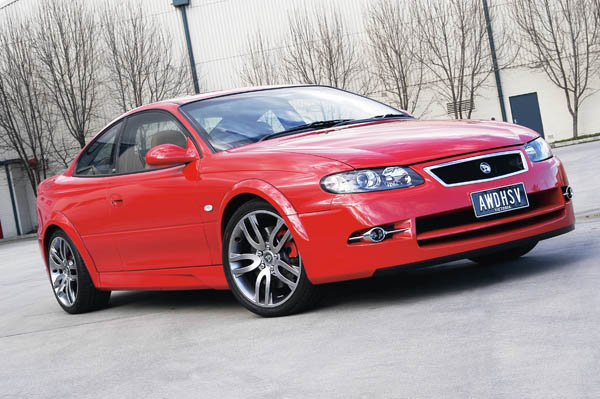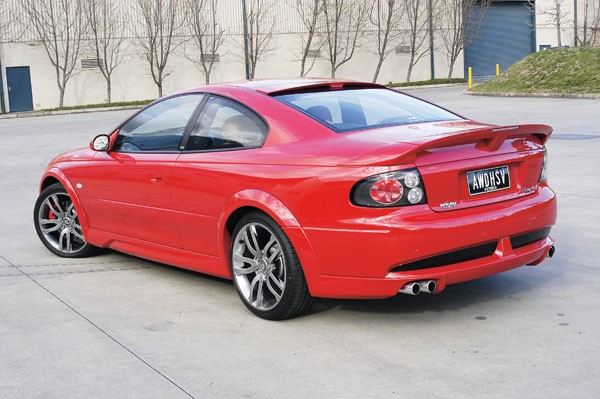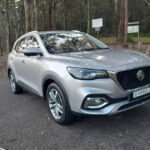
Monaro’s facelift gives it more visual presence on the road. HSV Coupe 4 s particularly strong in this regard
One very controversial feature distinguishes the VZ Monaro from its predecessor, a pair of bonnet scoops. Everyone who had the chance to talk to us during our road-test period wanted to discuss them. Some thought they looked just great, others liked the concept but weren’t over impressed by the execution. In particular, the doubters didn’t like the angle at which the scoops sat and/or would have preferred a bolder overall design.
One thing that all did agree on was the uprated exhaust note. The burble is back in the Holden V8. While it’s still muted by noise regulations that are amongst the toughest in the world, there’s certainly a more aggressive note to the updated Monaro. Holden redesigned the system from the catalytic converters back. A split exhaust is now possible because of the relocation of the fuel tank forward of the rear axle to suit USA safety requirements. Monaro, of course, is sold over there as the Pontiac GTO. The exhaust emerges as big bore 95mm tips on either side of the car.

That’s the positive side of the new fuel tank location, the negative side is the disappearance of about half the boot. What’s left is verging on being a joke, so if you plan to cart a lot of bulky gear around take a look under that bootlid before settling on a Monaro.
VZ Monaro’s powered by a Gen III 5.7-litre V8, now upgraded to provide peak power of 260kW, 15kW more than before. Previous criticism of lack of torque below 3000rpm has been addressed and the VZ Monaro is more driveable in commuting conditions.
It’s as thirsty as ever, though. In normal suburban running it typically used about 16 to 18 litres per hundred kilometres. This big V8 has always been at its best when in cruising mode and country trips will see consumption dropping to a much more reasonable 11 to 13 litres per hundred.
Monaro now has bigger brakes to balance its extra grunt. The solid rear discs have been replaced by ventilated units and a brake assist system (BAS) and electronic brakeforce distribution (EBD) are now standard.
The big Monaro handles superbly, turning into corners nicely and changing direction promptly and accurately when asked to do so. You do have to keep its mass in mind, though, when it comes to really tight stuff. Remember that this isn’t so much a sports car as a grand touring coupe and it all makes sense.
We also spent a week in an HSV Coupe 4, the high-performance all-wheel-drive version of the Monaro. This is a real beauty, with a wider track, big 19-inch alloy wheels and a striking body kit that features guard flares to cope with the extra suspension width. The revised body styling finally gives the Monaro an ultra-tough look to match that of the original Monaros of the 1960s. All who saw it loved the muscular new appearance.
Power is from a HSV-enhanced 5.7 V8, peaking at 279 kW, 400 horsepower at 5700 rpm. Top torque is 475 Nm at 4000 rpm, but there’s plenty of pulling power from about 1500 rpm onwards.
The HSV Coupe 4 isn’t a car for cafe cruising, it’s a genuine sports machine for real drivers. Get stuck into it and it really comes alive, both dynamically, where the benefits of driving through all four wheels really show, and in the way the engine gives you strong, willing performance in any gear under just about any circumstance.
These big two-door Holdens are worthy inheritors of the famed Monaro name, let’s just hope Holden keeps them in the lineup for many automotive generations to come.
AT A GLANCE
MODEL RANGE
Holden Monaro CV8 5.7-litre two-door coupe – $60,490
HSV Coupe 4 5.7-litre two-door coupe – $89,950
FEATURES
ABS Brakes: Standard in both models
Air Conditioning: Standard in both models
Automatic Transmission: No cost option in Monaro, not offered in Coupe 4
CD Player: Standard in both models
Central Locking: Standard in both models
Cruise Control: Standard in both models
Power Windows: Standard in both models
Driver Airbag: Standard in both models
Passenger Airbag: Standard in both models
Front Side Airbags: Standard in both models
SPECIFICATIONS (HSV Coupe 4 5.7-litre two-door coupe)
ENGINE
Capacity: 5.665 litres
Configuration: Longitudinal V8
Head Design: OHV, two valves per cylinder
Compression Ratio: 9.95:1
Bore/Stroke: 99.0 x 92.0mm
Maximum Power: 270kW @ 5700rpm
Maximum Torque: 475Nm @ 4000rpm
DRIVELINE
Driven Wheels: All-wheel-drive
Manual Transmission: Not offered
Automatic Transmission: Four-speed
Final Drive Ratio: 3.46:1
DIMENSIONS, WEIGHT AND CAPACITIES
Length: 4789mm
Wheelbase: 2788mm
Width: 1840mm
Height: 1397mm
Turning Circle: metres
Kerb Mass: 1802kg
Fuel Tank Capacity: 75 litres
Towing Ability: 500kg (1600kg with braked trailer)
SUSPENSION AND BRAKES
Front Suspension: Independent, MacPherson struts, cast-iron lower I-arms, coil springs, anti-roll bar
Rear Suspension: Independent, semi-trailing arm, coil springs, anti-roll bar
Front Brakes: Ventilated disc
Rear Brakes: Ventilated disc
PERFORMANCE
0-100 km/h Acceleration: 6.1 secs
Standing 400 Metres: 14.5 secs
FUEL CONSUMPTION
City Cycle: 15.7 L/100km
Highway Cycle: 11.4 L/100km
STANDARD WARRANTY
Three years/ 100,000 km











